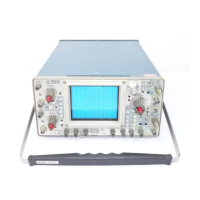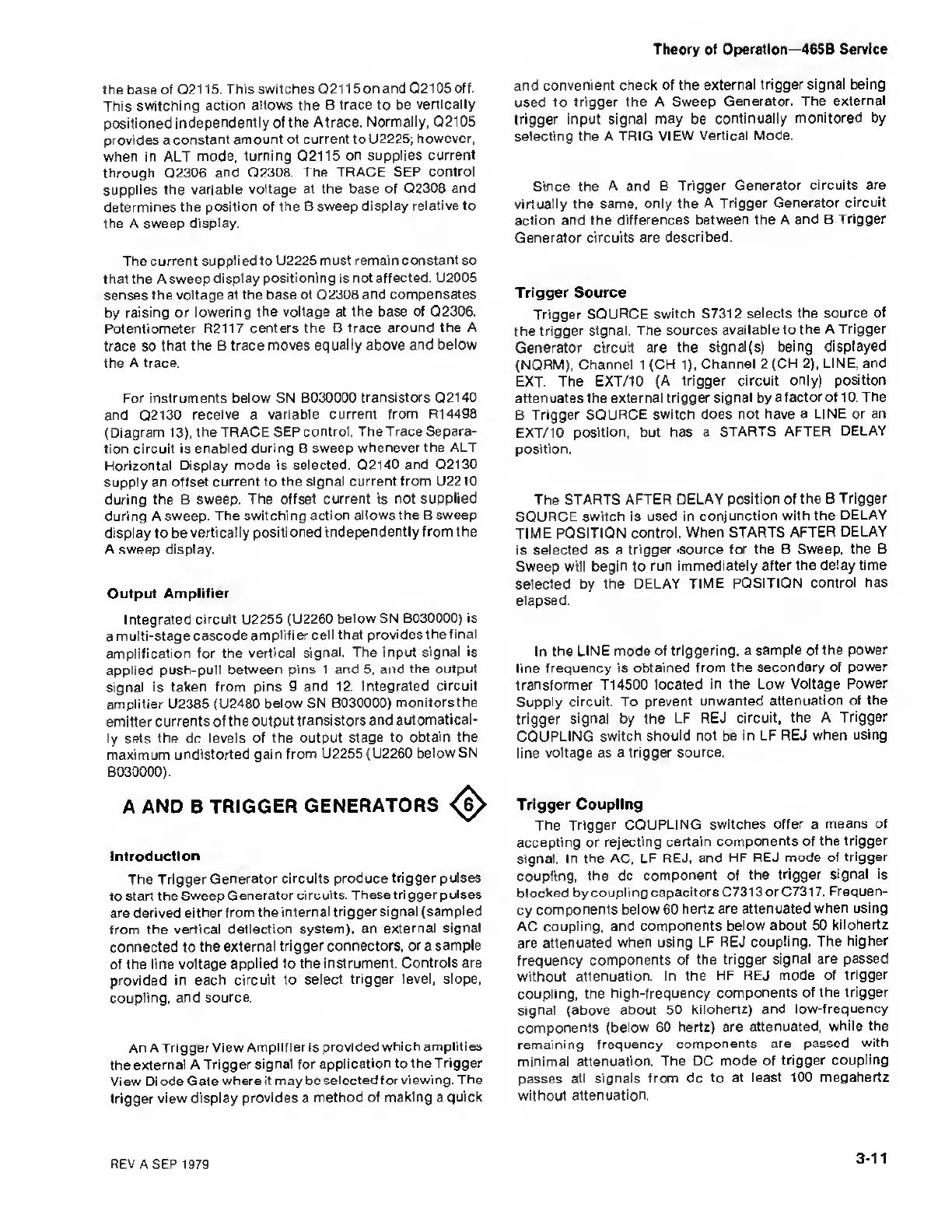Theory of Operation—465B Service
the base
of Q21 15.
This switches Q2115on
and Q2105off.
This switching
action allows the B
trace to
be
vertically
positioned
independently
of the Atrace.
Normally. Q2105
provides a
constant
amount
of
current to U2225;
however,
when in ALT mode,
turning Q2115 on supplies
current
through Q2306
and 02308. The
TRACE SEP control
supplies
the variable voltage
at the base of Q2308
and
determines the
position of the B sweep
display relative to
the A
sweep display.
The current supplied to U2225
must remain constant so
that the A sweep
display positioning
is
not affected. U2005
senses
the voltage at the base of Q2308
and compensates
by
raising
or
lowering the voltage at
the base
of
Q2306.
Potentiometer
R2117 centers the B trace around
the A
trace so
that the
B
trace moves
equally above and below
the A trace.
For instruments below SN B030000 transistors
Q2140
and
Q2130 receive a
variable current from R14498
(Diagram
13),
the TRACE SEP
control. The Trace Separa-
tion
circuit is enabled during B
sweep whenever the
ALT
Horizontal Display
mode is selected. Q2140
and Q2130
supply an offset
current to the
signal current from
U2210
during
the B
sweep.
The
offset
current is not
supplied
during A sweep.
The switching action allows the B
sweep
display to be vertically
positioned independently
from the
A sweep
display.
Output
Amplifier
Integrated circuit U2255 (U2260
below
SN B030000) is
a
multi-stage cascode
amplifier
cell that providesthefinal
amplification
for the vertical
signal. The input
signal is
applied
push-pull between pins 1
and
5,
and the
output
signal is
taken from pins 9
and 12. Integrated
circuit
amplifier U2385 (U2480
below SN
B030000)
monitorsthe
emitter
currents of the output
transistors and
automatical-
ly sets the dc levels
of the output stage to
obtain the
maximum undistorted
gain from U2255 (U2260
below SN
B030000)
.
A AND B
TRIGGER
GENERATORS
Introduction
The
Trigger
Generator circuits produce
trigger pulses
to
start the Sweep
Generator circuits. These
trigger pulses
are
derived eitherfrom
the internal trigger
signal (sampled
from the
vertical deflection
system), an
external signal
connected to
the external
trigger connectors, or a
sample
of
the line voltage applied to
the instrument.
Controls are
provided in each circuit
to select trigger
level, slope,
coupling,
and source.
An A Trigger
View Amplifier
Is provided which
amplifies
the
external A Trigger
signal for application to
the Trigger
View
Diode Gate where
it may
be
selected for
viewing. The
trigger view
display provides a
method of making a
quick
and convenient check of
the external trigger
signal being
used to trigger
the A Sweep Generator.
The external
trigger input signal may be
continually monitored
by
selecting
the A TRIG VIEW Vertical
Mode.
Since the
A
and B
Trigger Generator
circuits are
virtually
the same, only the
A Trigger Generator
circuit
action and the
differences between the A and B
Trigger
Generator circuits are described.
Trigger Source
Trigger SOURCE switch S7312
selects
the source of
the trigger signal.
The sources
available
to
the A Trigger
Generator circuit are
the signal(s) being
displayed
(NORM), Channel
1
(CH
1),
Channel
2
(CH
2),
LINE, and
EXT.
The EXT/10 (A trigger
circuit only)
position
attenuates the external trigger signal by a
factor
of
10. The
B
Trigger SOURCE switch does
not have a LINE or
an
EXT/10
position, but has a
STARTS AFTER DELAY
position.
The
STARTS AFTER DELAY
position
of
the B Trigger
SOURCE
switch is used in conjunction
with the DELAY
TIME
POSITION control.
When STARTS AFTER DELAY
is
selected as a
trigger
.source
for the
B
Sweep, the B
Sweep
will begin to run
immediately after the
delay time
selected by
the DELAY TIME
POSITION control has
elapsed.
In the
LINE mode of triggering, a
sample of the
power
line frequency is
obtained from the
secondary of power
transformer
T14500 located in the Low
Voltage Power
Supply
circuit. To prevent unwanted
attenuation of the
trigger
signal by the
LF REJ circuit,
the A Trigger
COUPLING switch should not be in LF
REJ when using
line voltage as a
trigger source.
Trigger Coupling
The
Trigger COUPLING
switches offer a means of
accepting
or rejecting
certain components of
the trigger
signal. In the AC,
LF REJ, and HF REJ
mode of trigger
coupling,
the
dc
component of
the trigger
signal
is
blocked by
coupling
capacitors
C7313
or C7317.
Frequen-
cy
components below 60
hertz are attenuated when
using
AC
coupling, and components below
about 50 kilohertz
are
attenuated when
using LF REJ
coupling. The higher
frequency components of the
trigger signal are
passed
without attenuation.
In the HF REJ mode
of trigger
coupling, the
high-frequency components of
the trigger
signal (above about 50
kilohertz) and
low-frequency
components
(below
60
hertz) are
attenuated,
while the
remaining frequency
components
are passed
with
minimal attenuation.
The DC mode of
trigger coupling
passes all
signals from dc to at
least
100
megahertz
without attenuation.
REV A SEP 1979
3-11

